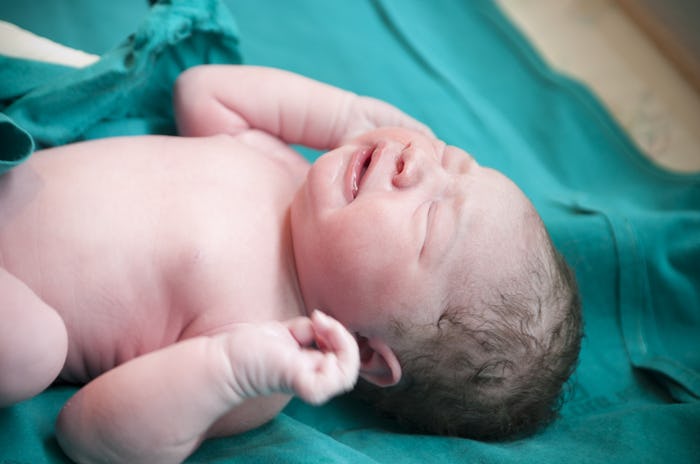Life

Before Adding It To Your Birth Plan, Here's What Experts Think About Vaginal Seeding
Vaginal seeding sounds like some kind of organic farming, but apparently it's taking the birthing world by storm. In a way. According to The American College of Obstetricians and Gynecologists (ACOG), vaginal seeding is "the practice of inoculating a cotton gauze or a cotton swab with vaginal fluids to transfer the vaginal flora to the mouth, nose, or skin of a newborn infant. The intended purpose of vaginal seeding is to transfer maternal vaginal bacteria to the newborn." It's a relatively new practice, and there are things experts want you to know about vaginal seeding. Like, is the practice really beneficial?
There is simple logic behind vaginal seeding. When babies are born vaginally, they come out... messy. They're covered in mom's vaginal fluids, and they've encountered bacteria from both mom's birth canal and rectum. Babies born via C-section, on the other hand, don't encounter this same bacteria. According to a blog post written by pediatrician Dr. Mark Sloan for Science and Sensibility, "Instead, bacteria from the skin and hospital environment quickly populate the bowel. As a result, the bacteria inhabiting the lower intestine following a cesarean birth can differ significantly from those found in the vaginally-born baby." Unfortunately, studies have linked the altered bacteria in a cesarean-birthed baby's gut to an increased risk for certain conditions. Megan Davidson, a Brooklyn-based doula and author of of the book Your Birth Plan, tells Romper, "Allergies, asthma, diabetes, and immune system problems have increasingly been linked to a deficiency of gut bacteria." Thus, vaginal seeding is an attempt to remedy this discrepancy by providing babies born via C-section with bacteria from their mother's vaginal fluids.
Now that we're clear on the basics, there are a few things that childbirth experts want expectant mothers to know.
Vaginal Seeding Replicates What Happens In A Vaginal Delivery
Karly Nutall, licensed midwife and co-host of the podcast Birth Kweens, explains in depth what happens when vaginal seeding is performed. "If someone is laboring and planning a vaginal delivery but it looks like a Cesarean is possible, or if a surgical birth is planned, you insert a sterile 4-inch by 4-inch gauze into the vagina for about an hour. You can take it out and store it in a container anytime after that. This gives plenty of time for the gauze to absorb the vaginal fluid, and most importantly the bacteria," Nutall explains to Romper. "If baby is born via surgery, this gauze is then used to swab the baby's face, mouth, nose, skin and the rest of the body, basically replicating the exposure to vaginal flora the baby would have experienced had it been born vaginally. The gauze can't be soaked postpartum because the vaginal flora is changed by bleeding, so if you plan to do this, you must soak the gauze before delivery."
Vaginal Seeding Has Not Been Studied Extensively
Vaginal seeding is new, and there simply haven't been many studies conducted that can tell us a whole lot. Of course, this doesn't mean that the practice isn't going to go anywhere in the future... it just hasn't yet. While one study done in 2016 showed that vaginal seeding was beneficial to C-section babies during their first month of life, this study only followed four babies, and didn't track long-term effects.
In other words, parents should be aware that this procedure is still in the "guinea pig" stage before they eagerly add it into their birth plan.
There Are Potential Risks To Vaginal Seeding
Of course, not all parents will choose to wait until ACOG makes a final judgment on this practice. "If individual parents do opt for vaginal seeding, the recommendation is that they have good counseling in advance about the potential risks associated with vaginal seeding, primarily the risk of passing less beneficial or infection to your newborn," Davidson tells Romper.
Laurelei Litke with HealthLabs.com lays out the specific risks. "It is important to note that some STDs, such as genital herpes, can be transmitted through vaginal fluids or skin contact alone. If a new mother wishes to undergo the process of vaginal seeding, she should get tested for STDs beforehand, as a C-section could potentially protect the baby from the further spread of the disease," Litke tells Romper.
If you've tested negative for infection and proceed with vaginal seeding, it's important that you tell your pediatrician you've done so.
At This Time, The American College Of Obstetricians & Gynecologists Does Not Recommend Or Encourage Vaginal Seeding
At least, they don't encourage it for normal, everyday parents. According to their website, "The American College of Obstetricians and Gynecologists does not recommend or encourage vaginal seeding outside of the context of an institutional review board-approved research protocol, and it is recommended that vaginal seeding otherwise not be performed until adequate data regarding the safety and benefit of the process become available." In other words, they encourage regular people like you or I to wait until the research is in.
There Are Other Sources Of Good Bacteria (Besides Vaginal Seeding)
Cesarean sections save lives daily, so don't be dismayed if you didn't have a vaginal birth. There are other ways to give your child that "good bacteria," and you can help set them up for a healthy life in other ways. According to Davidson, skin-to-skin contact with parents after birth and breastfeeding are both excellent ways to share bacteria that will ultimately inhabit their gut.